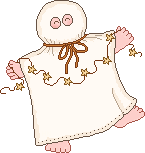|

Trick-or-Treat
The main event of Halloween is
trick-or-treating, or guising, in which children dress up in costume
disguises, and go door-to-door in their neighbourhood, ringing the bell
and yelling "trick or treat!" or "Halloween apples!" The occupant of the
house may then ask the child to do a party trick before giving some small
candies, miniature chocolate bars or other individually wrapped treats as
a reward. However the party trick is often dispensed with. Children can
often accumulate quite a lot of treats on Halloween night, filling up
entire pillow cases or shopping bags.
 The
custom of 'trick or treat' probably has several origins. Again mostly
Irish. An old Irish peasant practice called for going door to door to
collect money, bread cake, cheese, eggs, butter, nuts, apples, etc., in
preparation for the festival of St. Columbus Kill. Yet another custom was
the begging for soul cakes, or offerings for one's self - particularly in
exchange for promises of prosperity or protection against bad luck. It is
with this custom the concept of the fairies came to be incorporated as
people used to go door to door begging for treats. Failure to supply the
treats would usually result in practical jokes being visited on the owner
of the house. Since the fairies were abroad on this night, an offering of
food or milk was frequently left for them on the steps of the house, so
the house-owner could gain the blessings of the "good folk" for the coming
year. Many of the households would also leave out a "dumb supper" for the
spirits of the departed. The
custom of 'trick or treat' probably has several origins. Again mostly
Irish. An old Irish peasant practice called for going door to door to
collect money, bread cake, cheese, eggs, butter, nuts, apples, etc., in
preparation for the festival of St. Columbus Kill. Yet another custom was
the begging for soul cakes, or offerings for one's self - particularly in
exchange for promises of prosperity or protection against bad luck. It is
with this custom the concept of the fairies came to be incorporated as
people used to go door to door begging for treats. Failure to supply the
treats would usually result in practical jokes being visited on the owner
of the house. Since the fairies were abroad on this night, an offering of
food or milk was frequently left for them on the steps of the house, so
the house-owner could gain the blessings of the "good folk" for the coming
year. Many of the households would also leave out a "dumb supper" for the
spirits of the departed.
As far as
the custom across the Atlantic goes, by the mid- 20th century in Ireland
and Britain, the smaller children would dress up and parade to the
neighbors' houses, do little performances, then ask for a reward. American
kids seem to remember this with their chants of "Jingle bells, Batman
smells, Robin laid an egg," and other classic tunes done for no reason
other than because "it's traditional."
Typical Halloween costumes have traditionally
been monsters such as vampires, ghosts, witches, and devil. In 19th
century Ireland the reason for wearing such fearsome costumes was the
belief that since the spirits that were abroad that night were essentially
intent on doing harm, the best way to avoid this was to fool the spirits
into believing that you were one of them. In recent years however, more
contemporary costume ideas have also become popular, such as dressing up
as a character from a popular TV show or movie. It's not uncommon for
Halloween participants to celebrate by wearing costumes related to a
specific theme or time. 19th
century Ireland the reason for wearing such fearsome costumes was the
belief that since the spirits that were abroad that night were essentially
intent on doing harm, the best way to avoid this was to fool the spirits
into believing that you were one of them. In recent years however, more
contemporary costume ideas have also become popular, such as dressing up
as a character from a popular TV show or movie. It's not uncommon for
Halloween participants to celebrate by wearing costumes related to a
specific theme or time.
Trick or Treating usually ends when a child
enters his or her teenage years. Teenagers and adults instead often
celebrate Halloween with costume parties or other social get-togethers.

[ Back to Halloween Menu
]
[ Back to Holidays Land
]
[ Back to Our Home
]
Page created: Sep 7, 2004
Last updated: Sep 7, 2004
Information is from
Wikipedia,
The Holiday Spot.
Graphics are from
Graphics by
Irene,
Graphic Garden,
Nutmeg Creations.
|